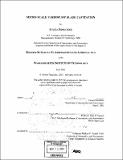| dc.contributor.advisor | Alan H. Epstein. | en_US |
| dc.contributor.author | Pennathur, Sumita, 1978- | en_US |
| dc.contributor.other | Massachusetts Institute of Technology. Dept. of Aeronautics and Astronautics. | en_US |
| dc.date.accessioned | 2005-08-23T22:37:30Z | |
| dc.date.available | 2005-08-23T22:37:30Z | |
| dc.date.copyright | 2001 | en_US |
| dc.date.issued | 2001 | en_US |
| dc.identifier.uri | http://hdl.handle.net/1721.1/8719 | |
| dc.description | Thesis (S.M.)--Massachusetts Institute of Technology, Dept. of Aeronautics and Astronautics, 2001. | en_US |
| dc.description | Includes bibliographical references (p. 195-196). | en_US |
| dc.description.abstract | The possibility of a silicon micro-fabricated turbopump for the use in a micro-fabricated bipropellant liquid rocket engine is of interest. Such a pump might have airfoils on the order of 1mm chord and 0.2mm span and operate at a Reynolds number of 6000. Cavitation is a major technical issue in such a pump, but there is little work in the literature at this length scale. This work documents analytical and experimental investigations of cavitation on millimeter long pump blading. Cavitation inception and bubble growth are analyzed on a micro-scale and deviations from macro-scale theory are discussed. The analysis suggests that residence time, surface roughness, surface tension, and passage area constraints are significant factors in cavitation inception and growth. A non-rotating microfabricated cascade has been designed, fabricated, and tested to quantify the behavior of micro-scale cavitation. An experimental rig has been constructed, and 18 micro-cascades have been tested. Visual observations confirm the existence of cavitation, and illustrate the phenomena of hysteresis and time lag. Comparisons of test results with analysis indicate that cavitation inception is adequately modeled by macro-scale theory. Test repeatability is established and the experimental data is found to be in agreement with 3D numerical results. Performance impacts of cavitation on micro-scale bade rows are discussed and several useful correlations are included. No apparent surface damage has been observed in these experiments. The experimental and analytical results are compiled in the form of design criteria for micro-scale turbopumps, and are used to evaluate the performance impacts due to cavitation. It is estimated that for a micro-turbopump operating at the most severe expected cavitating conditions, the performance loss in terms of pressure recovery is not greater than 20%. | en_US |
| dc.description.statementofresponsibility | by Sumita Pennathur. | en_US |
| dc.format.extent | 196 p. | en_US |
| dc.format.extent | 12126178 bytes | |
| dc.format.extent | 12125935 bytes | |
| dc.format.mimetype | application/pdf | |
| dc.format.mimetype | application/pdf | |
| dc.language.iso | eng | en_US |
| dc.publisher | Massachusetts Institute of Technology | en_US |
| dc.rights | M.I.T. theses are protected by copyright. They may be viewed from this source for any purpose, but reproduction or distribution in any format is prohibited without written permission. See provided URL for inquiries about permission. | en_US |
| dc.rights.uri | http://dspace.mit.edu/handle/1721.1/7582 | |
| dc.subject | Aeronautics and Astronautics. | en_US |
| dc.title | Micro-scale turbopump blade cavitation | en_US |
| dc.type | Thesis | en_US |
| dc.description.degree | S.M. | en_US |
| dc.contributor.department | Massachusetts Institute of Technology. Department of Aeronautics and Astronautics | |
| dc.identifier.oclc | 49884675 | en_US |
